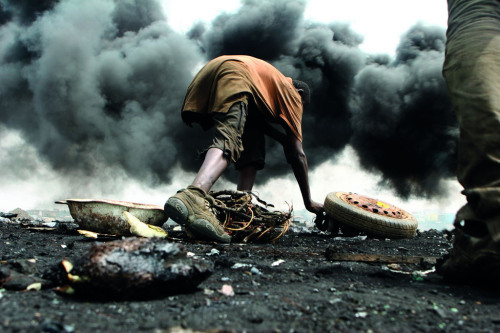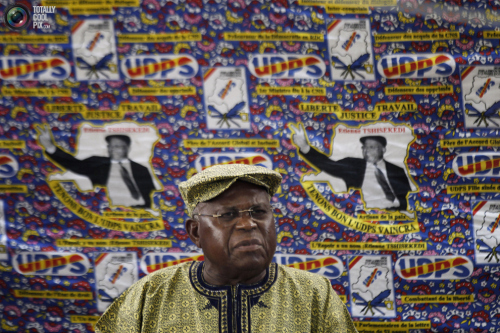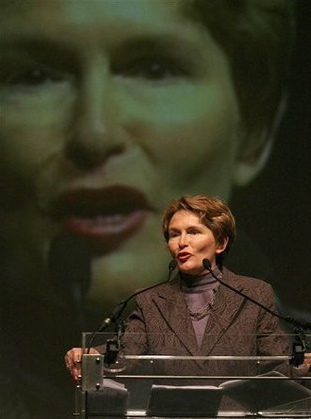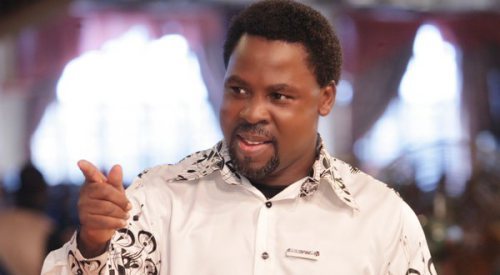Sean Jacobs's Blog, page 581
December 19, 2011
2011′s Music Video Picks
Inexplicably absent in this year's fashionable blogs' and magazines' year-end lists are videos by African artists, or those videos recorded somewhere in Africa. I've picked ten which I think stood out. South Africans Pieter Hugo and Michael Cleary directed and shot the video for Spoek Mathambo's 'Control' in Langa, Cape Town. We took issue with aspects of it when it came out in February, but that doesn't mean it isn't striking:
Directed by Juliet Rios and Gabe Imlay, and choreographed by "Fela!" on Broadway assistant choreographer Maija Garcia, the video for Seun Kuti's 'Rise' comes close to capturing his live performances. It was released in April:
Blitz The Ambassador calls his album Native Sun "a journey backwards, back through hip hop, the Caribbean soundsystem culture that preceded it, back to its African roots, with the final kora." This historical journey and the return to his land of birth, Ghana, are reflected in the stream of archive material used when Blitz threw the full album on YouTube, also in April:
In May, Buraka Som Sistema released the video for their kuduro-infused 'Hangover (BaBaBa)'. Directed by João Pedro Moreira and Carlos Afonso, the video uses images from the Portuguese band's performance at the Festival Baía das Gatas in São Vicente, one of Cape Verde's islands:

When Tumi shared his POWA mixtape in June, it came with a video directed by Teboho Mahlatsi. The school girls who go on a violent Clockwork Orange-like rampage are as angry as Tumi's lyrics, with the end of the video leaving the viewer confused:
In July, Nneka came up with a first animated video for the title song of her album 'Soul is Heavy' (and got the hang of it because she released a second one just last month):
If you were to rely on the average South African music video (especially the kwaito-heavy ones from Johannesburg), you'd be forgiven for believing South African city life is all about heavy boozing, tuning and styling. Director Anne-Sophie Leens and Cape Town spaza crew Driemanskap showed us the flip-side of those cities in the video for 'I Will Make It', recorded in Gugulethu:
Still in July, J Majik and Wickaman cleverly used Josh Cole's images of Rwandan and Burundian dancers in the streets of Kigali and Bujumbura. I wonder whether the dancers got to see the video themselves:
I hadn't heard of Kommanda Obbs before August when he plugged the video for 'Ts'epe', recorded in Lesotho. Pheello Makosholo captures the country's high mountain life in black and white unlike any Sotho music video I have seen before:
And finally, in October, X Plastaz released the video for 'Africa' with the island of Zanzibar and the streets of the Tanzanian crew's home town Arusha as their stage. The scenery is efficient enough, but the one reason why I think it works is for their subtitling of the lyrics. Raps and lyrics by artists trying to stay true to their local audience in Swahili, Zulu, Lingala, Arabic or Wolof are often lost on the African diaspora so eager to connect with these songs and artists — an easy English or French YouTube translation will get the artists' message out in a way no other social platform or expensive overseas touring can.








10 photographers to watch in 2012
As part of a series of year-end posts–we're taking a break from Friday, December 23, till January 5, 2012–we're planning to post at least 10 "Lists of 10″ this week. (We're trying to be cool by calling it "10×10″). So two lists per day. Orlando Reade, who blogs for us from London, starts us of with his list of 10 photographers to watch in 2012. He's picked five African artists and five Europeans who have been working in Africa–Sean Jacobs and Tom Devriendt.
Nyaba Leon Ouedraogo's (born Burkina Faso, 1978) L'enfer du Cuivre (image above) and Pieter Hugo's (born South Africa, 1976) Permanent Error series both document life in and around the technology dump in Agbobloshie, Ghana.
Lien Botha's (born South Africa, 1961) 2009 Parrot Jungle series, exhibited at this year's Bamako biennial, explores the iconography of natural history. Her images, carefully and oddly juxtaposed objects, possess the aura of an old cabinet of curiosities.
Nii Obodai's (born Ghana, 1963) work, From the Edge to the Core, was exhibited at the Bamako biennale. The 2009 series, Who Knows Tomorrow, a collaboration with the Algerian-French photographer Bruno Boudjelal explored the political legacies of Kwame Nkrumah's independent nation through landscape portraits of urban and rural Ghana.
Daniel Naudé (born South Africa, 1984) makes portraits of animals in strange relation to their landscapes. His Africanis series focused on the wild dogs of the Karoo.
Cecile Mella's (born France, 1983) series 'Fictional Cape Town', captures the misfigured and fantastical portraits of the city at the edges of advertising photo-shoots and film-sets.
Jordi Cami's (born Spain, 1955) images of the industry of manual transporting at the border of Spain and Morocco, and infant refugees in Sudan, make intimate reportage of physical life in these communities.
Four years ago, Yan Gross (born Switzerland, 1981) started making a series on a group of skateboarders in Kitintale, a suburb of Kampala, who built what Gross claims is the first skatepark in East Africa. The project is ongoing.
Andrea Stultiens (born Holland, 1974) has been working and teaching in Uganda for the last few years, engaging with local artists through the Bayimba Photography Workshops. The Kaddu Wasswa Archive is a series devoted to one man's life, compiling documents from his past with new photographs. This work, made in collaboration with Wasswa's grandson, the photographer Arthur C. Kisitu, indirectly makes a history of the first fifty years of independent Uganda.
Alfredo d'Amato's (born Italy) series, 'The Sound of Kuduro', explored the Kuduro (translated as "hard ass") music scene in Luanda, Angola. It was exhibited at this year's Lagos Photo. Amato's 'Early Days of Spring' contains eloquent portraits of Tunisia after the end of Ben Ali's regime. His recent work in Mozambique can be seen here.








December 18, 2011
Paris is a Continent, N°6
I thought I'd continue my focus on French women singers. First up is Kenya Samet: great voice, from Algeria. This song named "Yema" (mother in Arabic) is about the love for the mums. It features Indila (remember her).
A medley of several French singers freestyle over Jay-Z's "Big Pimpin," while promoting the first Zaho opus "Dima": Amel Bent, Kaylene, Lady Laystee, Melissa, all donate a verse. I know it's old but it's a freestyle with several singers so here we go.
Kenza Farah, featured here before, "Sans jamais se plaindre."
Finally, a breakup song women like, "Je regarde en l'air"–by a man: Mister You








December 17, 2011
How to write about elections in Africa
With a few elections coming up next year, journalist Jina Moore already has the template down for covering them:
These days, nowhere are crises more predictable than in __________ (poor/recently violent country). And yet, when they unfold as anticipated, Western policymakers and diplomats always seem caught off guard — raising questions about the competence, willingness, and commitment of the ________(capital city)-based diplomatic corps and the United Nations mission to discharge their responsibilities."
"….Nothing underscores the apathy and inconsistency that characterize Western diplomacy in _____ more than the current impasse…The legitimacy crisis threatens to trigger another round of civil war in a country that has already __________ (short-phrase recap of how many people died there in recent memory, thereby justifying interest)."
"The ____________[major INGO] cited serious irregularities, including the loss of _____ (electoral documents) in _______ (city/town/village), a _____ stronghold….. Meanwhile, according to ________ (INGO) multiple locations in _______ (another city/town/village), a bastion of __________ (current ruler) supporters, reported impossibly high rates of 99 to [over] 100 percent voter turnout, with all or nearly all votes going to the incumbent." (Note: Some wisely fix this slightly lower than 99 percent; adjust as needed.)
"….As grievances and disputes over electoral law arose, the CENI [independent electoral commission] failed to provide an adequate forum for dialogue with the opposition." (Sorry, players, that one goes verbatim in every election post-game.)
"…..The independence of these commissioners has been called into question as _____ has regularly shown bias against ______"
"…..These same international actors remained silent about the allegations of fraud and irregularities, even as _________ (local/national orgs) denounced violence and abuses. Their silence has helped spawned (sic) a crisis that could have easily been averted."
"…. ________ (incumbent) waited nearly ___________ days(/hours) to hold a news conference and react to… _____________ (oppostion's) rejection of the results.








R.I.P. Cesária Évora
Dances with Samburu
The Samburu of northern Kenya are pastoralists, and they are under attack. According to Survival International, two US-based charities — the Nature Conservancy and the Africa Wildlife Foundation — bought lots of land, from Daniel arap Moi. How did he get the land? Good question.
The Samburu, who had been forced out of nomadic pastoralism by the encroachment of fenced off ranches, had settled there twenty years earlier. For twenty years they used this piece of land for grazing and access to water. They made land decisions on communal interests, with no one having the right to permanently dispose of the land. While the decision making process was dominated by male elders, women, especially married women, were involved in decisions concerning land use and allocation.
Until Daniel arap Moi bought the land, no questions asked. Then he sold it to charities.
Since the sale, the Samburu have been harassed, beaten, raped. The lucky ones have "simply" been evicted and had to fend for themselves in makeshift lean-tos. The Samburu have gone to court to retain their land, and to get some justice. Africa Wildlife Foundation has "gifted" the land to Kenya, for "conservation."
It is a familiar enough story: "Native people" caught in the crosshairs of conservation, charity, and gift economies bestowed upon them by the good people of the Global North. But there is more. The Guardian featured Samburu women prominently … in pictures. In the paper, Samburu women "sing a song" and "wear colorful beaded necklaces."
It's not the first time that foreigners have visited sexual violence on Samburu women in the name of progress and civilization. For the past fifty years the Kenyan government has leased land in the Samburu District to the British military. It's a training ground. Over 600 complaints of rape have been filed against the British military. Women like Miliyan LeKanta, Lydia Juma and Nigaripen Lesiamito have testified, in public, to the rapes. Testimony that resulted in their isolation and even expulsion from their own communities. The "internal" British investigation found the military not guilty. Then the Kenyans "lost" the evidence. As the women's lawyer explained, "There is no glory in reporting rape."
That struggle is ongoing and it's more than colorful beads and the singing of songs. Locally, the Samburu Women for Education & Environment Development Organization has been key in documenting the devastation of the evictions and abuse on the Samburu. In their report, which Survival International sent to the United Nations, they have shown the ways in which women as herders and farmers have been rendered helpless by the violence of police. They also have reported on women who have had to watch as their husbands have been beaten, sometimes to death, by police or by paramilitaries, and then left for dead in the fields. Houses are burned, villages ransacked, women raped. Sometimes, it is the price of charity.
The bitter irony of conservation here is that the Samburu women are actually at the heart of the indigenous preservation of wildlife, in particular of elephants. The Samburu claims a kinship between elephants and Samburu women. It is a kinship of everyday village labor. This kinship results in cultures of respect and honor. It is a kinship which is hard to translate into a language of not-for-profit multinational charitable organizations, their ears more attuned to Samburu women singing and wearing fantastic bead necklaces.








Dances with Samburu Women
The Samburu of northern Kenya are pastoralists, and they are under attack. According to Survival International, two US-based charities — the Nature Conservancy and the Africa Wildlife Foundation — bought lots of land, from Daniel arap Moi. How did he get the land? Good question.
The Samburu, who had been forced out of nomadic pastoralism by the encroachment of fenced off ranches, had settled there twenty years earlier. For twenty years they used this piece of land for grazing and access to water. They made land decisions on communal interests, with no one having the right to permanently dispose of the land. While the decision making process was dominated by male elders, women, especially married women, were involved in decisions concerning land use and allocation.
Until Daniel arap Moi bought the land, no questions asked. Then he sold it to charities.
Since the sale, the Samburu have been harassed, beaten, raped. The lucky ones have "simply" been evicted and had to fend for themselves in makeshift lean-tos. The Samburu have gone to court to retain their land, and to get some justice. Africa Wildlife Foundation has "gifted" the land to Kenya, for "conservation."
It is a familiar enough story: "Native people" caught in the crosshairs of conservation, charity, and gift economies bestowed upon them by the good people of the Global North. But there is more. The Guardian featured Samburu women prominently … in pictures. In the paper, Samburu women "sing a song" and "wear colorful beaded necklaces."
It's not the first time that foreigners have visited sexual violence on Samburu women in the name of progress and civilization. For the past fifty years the Kenyan government has leased land in the Samburu District to the British military. It's a training ground. Over 600 complaints of rape have been filed against the British military. Women like Miliyan LeKanta, Lydia Juma and Nigaripen Lesiamito have testified, in public, to the rapes. Testimony that resulted in their isolation and even expulsion from their own communities. The "internal" British investigation found the military not guilty. Then the Kenyans "lost" the evidence. As the women's lawyer explained, "There is no glory in reporting rape."
That struggle is ongoing and it's more than colorful beads and the singing of songs. Locally, the Samburu Women for Education & Environment Development Organization has been key in documenting the devastation of the evictions and abuse on the Samburu. In their report, which Survival International sent to the United Nations, they have shown the ways in which women as herders and farmers have been rendered helpless by the violence of police. They also have reported on women who have had to watch as their husbands have been beaten, sometimes to death, by police or by paramilitaries, and then left for dead in the fields. Houses are burned, villages ransacked, women raped. Sometimes, it is the price of charity.
The bitter irony of conservation here is that the Samburu women are actually at the heart of the indigenous preservation of wildlife, in particular of elephants. The Samburu claims a kinship between elephants and Samburu women. It is a kinship of everyday village labor. This kinship results in cultures of respect and honor. It is a kinship which is hard to translate into a language of not-for-profit multinational charitable organizations, their ears more attuned to Samburu women singing and wearing fantastic bead necklaces.








December 16, 2011
Music Break. Friday Bonus Edition
Ploughing through the blog's archives to come up with a fair selection of ten videos for next week's year-end lists, I wondered why we haven't written about the Congolese Salaam Kivu All Stars. Things went well in Goma, Kivu during the elections last week. A year ago, youth and media organization Yole! Africa staged the SKIFF festival in Goma (where they also shot the first video below), and they were planning to do so again this year. 'Saisir l'Avenir' means as much as 'to seize the Future.'
Get ready for a work out. Angolans The Shine and Portugal's Throes do "kuduru rock":
Okay, after that workout, we can slow down. Nice 10 minute live set by James Farm, the American "acoustic jazz quartet" consisting of saxophonist Joshua Redman, pianist Aaron Parks, bassist Matt Penman, and drummer Eric Harland. Recorded at The Jazz Standard.
And 18 minutes (also recorded live at The Jazz Standard) of Ambrose Akinmusire and his Orchestra:
Finally, we had this one on our Facebook page earlier this week. Tamikrest backstage at a music festival in Switzerland:








Helen Zille's 'AIDS Gestapo'
Just as South Africa is recovering from the havoc wrought by former President Thabo Mbeki's AIDS denialism, now there's a new politician spouting all sorts of nonsense – this time it's Helen Zille, the leader of the opposition Democratic Alliance. She's been active on Twitter and in the media, calling for the criminalization of HIV transmission, and saying the state should not have to pay for treatment for those who contracted HIV through irresponsible behavior. She also recently held a lottery, where people who volunteered to get tested for HIV could win a large cash prize.
Zille's remarks have inspired a wave of criticism and counter-criticism. AIDS activist Nathan Geffen has been the most vocal in his carefully reasoned critique of Zille's arguments, joined by Francois Venter, outgoing president of the SA HIV Clinicians Society, and, finally, renowned author on AIDS in Africa, Helen Epstein. Several prominent figures have come out in support of Zille, or confessed their befuddlement, while Zille herself seems to have gone off the deep end, calling her critics among other things, the 'AIDS Gestapo.' All of which has played out in the social media sphere, on Twitter and Facebook, and in mainstream publications – though doesn't seem to have been picked up by the foreign media–drowned out most likely by panic over the passing of the so-called 'secrecy bill' and coverage of the climate change conference in Durban.
Since Geffen and others do a far more effective job of pointing out Zille's irrationality than I could ever hope to, I see no point in repeating the arguments (follow the links above if you want all the details). What doesn't seem to have been emphasized enough though, is that while Zille has been spending time on populist and damaging nonsense, we in fact do know how to effectively combat HIV. What we need is politicians with the sense and integrity to make it happen. While Zille plays off treatment against prevention, saying we need less of the former and more of the latter, we now know without a doubt that treatment IS prevention. Effective ARV treatment not only saves the lives of those with HIV, but it dramatically cuts down on the spread of the virus. Yet just at the point where we have the ability to turn the tide, politicians have decided to cut spending on treatment, placing the Global Fund in crisis and placing millions of lives in jeopardy. While we know condoms protect, we also know there are not nearly enough of them available–in some areas, less than ten per sexually active man, per year.
We also know very well, that one of the most effective ways of fighting the spread of HIV is to protect human rights – and in particular, the human rights of sex workers.
Yet after months of negotiations a section calling for the decriminalization of sex work was omitted from South Africa's National Strategic Plan on AIDS, at the last minute. While we know condoms work and while we know that protecting sex workers protects all of us, police in South Africa–and in many other countries–continue to view possession of condoms as evidence of sex work, and thus an excuse for confiscations and arrests.
While we know ARVs and other drugs save lives, we also know that trade policies that offer excessive protection to pharmaceutical patents mean many life-saving drugs remain unaffordable, or mean governments can buy far fewer drugs than are needed. If Zille and other politicians really cared about reversing the tide of HIV and AIDS instead of just making the headlines or picking up a few more votes, she would be railing against these insane and unjust policies. She would be lobbying for continued funding for treatment, she'd push for better condom distribution, she'd be calling for the decriminalisation of sex work. She's doing none of these things.








December 15, 2011
Nigeria's Prophets
By now you've probably watched the (British) Channel 4 TV documentary film about Nigeria's millionaire preachers–the fake healings, buckets full of money, police escorts, mall openings and the flash. I watched it last night. Nigerian blogs, not surprisingly, have focused on theological debates thrown up by the documentary. (One of the preachers, Dr Fireman, when quizzed about his ostentatious show of wealth, responds: "Jesus was rich and had an accountant who followed him around.") Notably absent from the program were the really rich preachers–compiled in a list by a Forbes blogger earlier this Fall– like David Oyedepo (estimated net worth of $150m), Chris Oyakhilome ($30-50m) and TB Joshua ($10-15m).
Joshua is probably the most interesting (there's even a TB Joshua Watch online). He is also politically well connected.
Joshua claims to heal HIV/AIDS, cancer and paralysis at his Synagogue Church of All Nations in Lagos.
He has found a willing audience amongst African elites.
In one celebrated case, Jaco van der Westhuyzen, a top rugby player from South Africa traveled to Lagos with a knee injury and claimed to be healed by TB Joshua. Two other national rugby team players with cancers followed and stopped treatment or using their medicine. But after visiting Joshua's church in Nigeria — Ruben Kruger and Wuim Basson — they died of their cancers. Their failure to get well is usually rationalized as either their lack of faith. (In Basson's case, Joshua even claimed to communicate with the dead Basson.) South African television has reported stories of white South Africans traveling in large groups to Joshua's church for healing.
As for the politically connected who travel to see and hear Joshua in Nigeria, they include Ghanaian president John Atta Mills, of whom it is claimed that "Joshua had prophesied his victory in the Ghanaian polls, specifying there would be three elections and the results would be released in January." Atta Mills has described Joshua as a mentor. A Zimbabwean newspaper reported that prime minister Morgan Tsvangirai visited Joshua's church in September. So have other leaders of Tsvangirai's MDC movement as well as Mugabe's ZANU-PF. Some were hoping it would give them an edge in party political contests. The same newspaper mentioned a few other high profile guests: former presidents Frederick Chiluba (Zambia), Pascal Lissouba (Congo-Brazzaville), André Kolimba (Central African Republic), Omar Bongo (Gabon) and Zulu King Goodwill Zwelithini (who came to testify about his "daughter's healing from epilepsy"). The president of Zimbabwe's football association Cuthbert Dube also claimed to be healed by Joshua.
Not all governing elites are as welcoming. Cameroon has banned Joshua.
But probably the most curious recent guest at Joshua's church has been Winnie Mandela, seen in this recent video, below, with Joshua's Emmanuel TV referring to herself as "the grandmother of Africa," blaming everything on modernity (except Christianity of course) and suggesting Africa needs "democracy of a special type":

Given some of our obsession with South Africans, we keep wondering why do South Africans travel to Nigeria, when they have their own miracle-making farmer at home?








Sean Jacobs's Blog
- Sean Jacobs's profile
- 4 followers


























